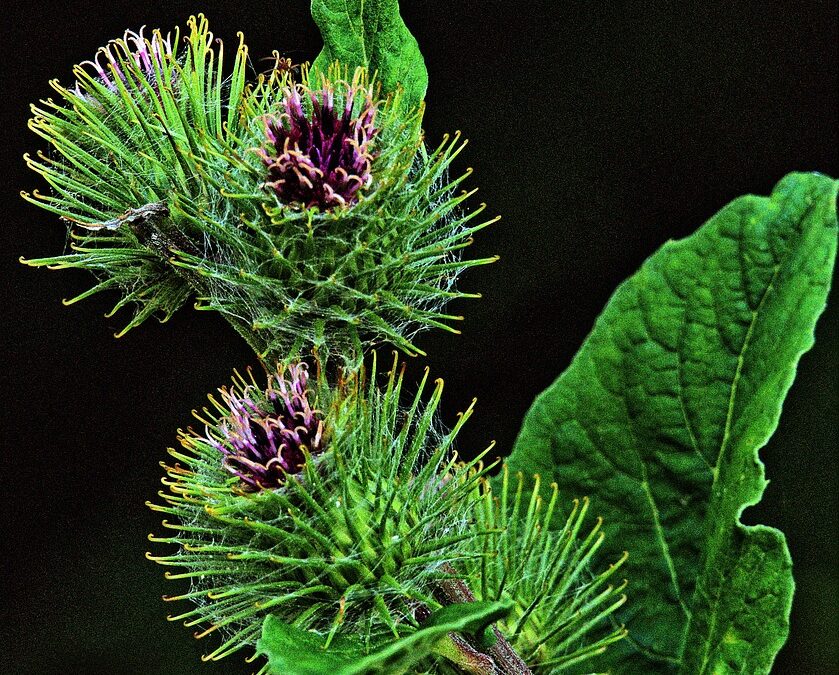Botanically Speaking
Burdock has spread to many parts of the Northern Hemisphere. It grows in full or partial sun in a variety of soil conditions.
It is a biennial plant, meaning that it completes its life cycle in two years.
In the first year’s growth, it develops large simple basal leaves that grow near to the ground. It produces a long taproot that is pithy white in the center and covered in a thin brown skin. Burdock root is best harvested in the fall (November in Northern Colorado) of the first year of growth. Because burdock likes to grow in compact soils and the roots go deep into the earth, harvesting the wild root can be quite challenging. I like to harvest mine in well-prepared soil that is composted every year. I use a pitchfork to loosen the dirt before digging for the root.
In the second year, it forms a central flower stalk that can grow from 3 to 6 feet tall. The flower is a purple thistle-like flower that then develops into a structure containing small hard fruits, commonly, but technically incorrectly, called seeds. After the fruits are developed, the individual plant dies. No need to grab your tissues, however, as it has assuredly done a good job of reproducing for the next generation. Those dried burrs quickly grab onto anything they come in contact with, whether it’s animal fur or your favorite jacket. They burrow in and hitch a ride to spread their seeds far and wide. Burdock burrs may have been the inspiration for Velcro®.
Using Burdock
While burdock root is used as medicine by herbalists, it is best used as food for maintain health. If you want to avoid the back-breaking, calorie-burning experience of harvesting the wild root, you can often find it being sold as “gobo” in Asian grocery stores or health food stores. A handful of chopped fresh or dry burdock root cooked with rice is one easy way to incorporate it into your diet. The leaf stems of the first-year plant can be peeled and eaten fresh or cooked.

Burdock is a favorite alterative that is especially used by herbalists for restoring healthy skin. The root provides deep nourishment and is best used long-term for chronic illnesses. The seeds offer faster-acting results that are often used for more acute symptoms, such as red swollen throats or urinary problems. The large leaves of burdock can be used externally as poultices for burns or rheumatism. While there are many important uses for burdock, it’s rarely “convenient” medicine. The roots can be difficult to dig and the fruits can be challenging to separate from their burrs. Even still, burdock remains a popular herb for healthy skin secretions, as a diuretic, and also for cancer support.
Burdock Vinegar
Burdock root dried
Apple cider vinegar
Fill a clean jar 1/3 full of dried root. Fill the jar again to the top with vinegar. Place a plastic lid on the jar and store in a cool and dry place for 6 weeks. Shake daily. Strain after 6 weeks and compost the plant material.
I keep mine in the refrigerator if using vinegar with the mother in it. I use this vinegar for salad dressing and in soups all winter long.
Wishing you happiness and health,
Chrystal Cocek
Colorado Herbalist
Integrated Earth Medicine, Loveland, Colorado

